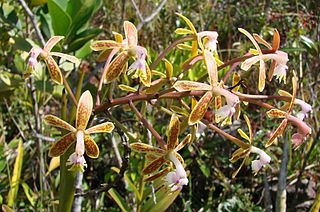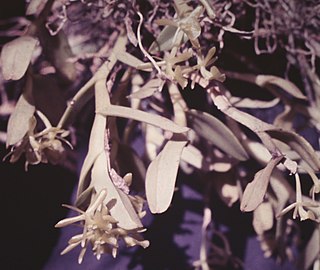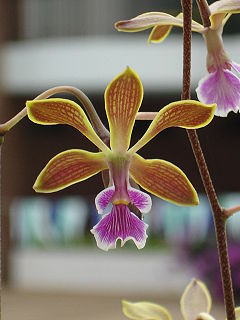
Epidendrum, abbreviated Epi in the horticultural trade, is a large neotropical genus of the orchid family. With more than 1,500 species, some authors describe it as a mega-genus. The genus name refers to its epiphytic growth habit.

Coilostylis is a genus of orchids. It was split off from the "supergenus" Epidendrum in 2004. This genus features pseudobulbs, large bracts around the flowers, and flowers that are typically resupinate, with the trilobate lip adnate to the column and having a long thin midlobe. It is not unusual for this genus to produce keikes.

Laeliinae is a Neotropical subtribe including 40 orchid genera, such as Brassavola, Laelia and Cattleya. The genus Epidendrum is the largest within this subtribe, containing about 1500 species. This is followed by the genus Encyclia, with over 120 species.

Panarica is a genus in the orchid family (Orchidaceae) and contains 6 species.

Epidendrum cinnabarinum, is a terrestrial reed-stemmed Epidendrum, discovered by the German collector Philipp Salzmann in Bahia, close to Salvador, and published by John Lindley in 1831. The specific epithet refers to the vermilion flowers. E. cinnabarinum is similar to E. fulgens and E. puniceoluteum, as well as red forms of the other crucifix orchids.

Coilostylis falcata, formerly Epidendrum falcatum, is an orchid in the genus Coilostylis, a genus recently resurrected and split from Epidendrum.

Epidendrum blepharistes is a species of orchid in the genus Epidendrum native to Bolivia, Colombia, Costa Rica, Ecuador, Peru, and Venezuela.

Epidendrum cristatumRuiz & Pav. (1789) is a species of orchid in the genus Epidendrum which is known to grow both terrestrially and epiphytically at altitudes near 1 km in the Neotropics from Mexico through Brazil, as well as Trinidad.

Epidendrum difforme is a species of orchid in the genus Epidendrum. In 1861, Müller classified this species in the subsection Umbellata of the section Planifolia of subgenus EuepidendrumLindl. of the genus Epidendrum.

Epidendrum magnoliae, sometimes called Epidendrum conopseum or the green-fly orchid, is a species of orchid in the genus Epidendrum. It is the most northern-growing epiphytic orchid in North America, being found wild in the southeastern United States from Louisiana to North Carolina, and also in northeastern Mexico.

Epidendrum nocturnum is the type species of the genus Epidendrum of the Orchidaceae . The species occurs in Florida, Bahamas, West Indies, Central America to northern Brazil and the Guyanas. Epidendrum nocturnum is common in South Florida.

Epidendrum paniculatum is a species of orchid in the genus Epidendrum.

Encyclia oncidioides is a species of orchid. The diploid chromosome number of E. oncidioides has been determined as 2n = 40.
Epidendrum latilabre is a species of orchid of the genus Epidendrum which occurs naturally in French Guyana, Peru and Brazil. The diploid chromosome number of E. latilabre has been determined as 2n = 40.

Epidendrum rigidum is an epiphytic reed-stemmed Epidendrum orchid common throughout the Neotroical lowlands, below 600 m.

Epidendrum calanthum is a terrestrial reed-stemmed Epidendrum orchid from the montane Tropical rainforest of Bolivia, Colombia, Ecuador, Peru, Venezuela, and the West Indies.
Epidendrum lanipes is an epiphytic sympodial orchid with spindle-shaped stems native to the montane tropical rainforest of Bolivia, Colombia, Ecuador, and Peru at altitudes ranging from 0.8 to 1.4 km.
Epidendrum subgenus Aulizeum was raised from sectional status by Lindley in 1853. According to the Latin diagnosis, this taxon included those species of Epidendrum with a multi-lobate lip adnate to the column, with pseudobulbous stems, with the flowers sessile or born on racemes or panicles. In his further English description, Lindley stated that the species in this taxon have a horn-like stem which is only leafy at the end, and racemose inflorescences. In 1861, Reichenbach listed 32 species in this subgenus; of these, Kew recognizes 31 as separate species.
Epidendrum cochlidium is a neotropical orchid which can grow both terrestrially and epiphytically in Peru and Venezuela at altitudes ranging from 1.2 km to 2.9 km.














